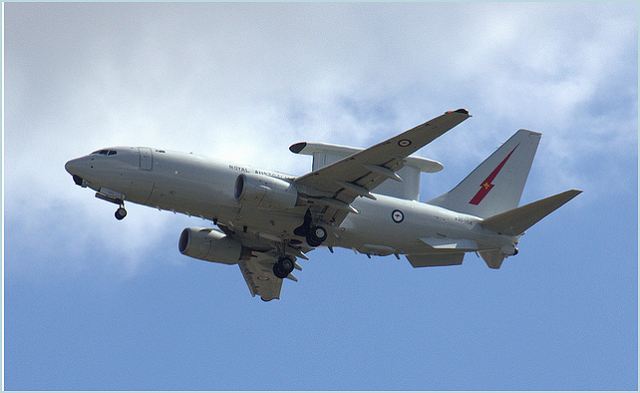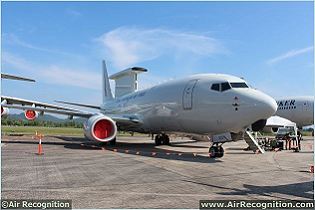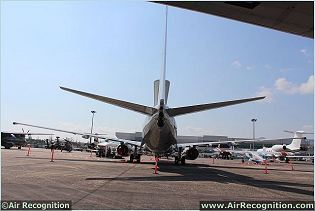| |
||||||||||||||||||||||
| a | ||||||||||||||||||||||
E-7A
WEDGETAIL Airborne Early Warning & Control aircraft |
||||||||||||||||||||||
 |
||||||||||||||||||||||
| |
||||||||||||||||||||||
The
first E-7A Wedgetail Airborne Early Warning & Control (AEW&C)
aircraft was delivered to Australia in 2009 and began operations in
2010. A total of 6 aircraft have been delivered to Australia. The E-7A
Wedgetail represents an entirely new capability for the ADF (Royal Australian
Air Force), providing a platform that will gather information from a
wide variety of sources, analyse it and distribute it to all friendly
air and surface assets. AEW&C aircraft can control the tactical
battle space, providing direction for fighter aircraft, surface combatants
and land based elements, as well as supporting aircraft such as tankers
and intelligence platforms. The E-7A Wedgetail is therefore a major
new capability for the Australian Defence Force, which will significantly
multiply the effectiveness of our existing Navy, Army, Air Force and
Coastwatch, and help Australia maintain a capability edge well into
the future. The E-7A Wedgetail is truly the “Eyes of the Nation”. |
||||||||||||||||||||||
| Main Variants | ||||||||||||||||||||||
-
No variants. |
||||||||||||||||||||||
| Technical Data | ||||||||||||||||||||||
| Design | ||||||||||||||||||||||
Based
on the 737-700 commercial airliner airframe, the E-7A features advanced
multirole electronically scanned radar and 10 state-of-the-art mission
crew consoles that are able to track airborne and maritime targets simultaneously. |
||||||||||||||||||||||
| Avionics an equipment | ||||||||||||||||||||||
| The
E-7A Wedgetail is equipped with ventral fins to counterbalance the radar
and countermeasures mounted on the nose, wingtips and tail. In-flight
refueling is via a receptacle on top of the forward fuselage. The cabin
features eight operator consoles with sufficient space for four more;
the Australian fleet will operate ten consoles with space for two more
(four on port side and six on the starboard side). - Multi-role electronically scanned array (MESA) radar with range in excess of 400km - Electronic warfare self-protection measures including directed infra-red counter-measures, chaff and flares - Communication systems including HF, VHF, UHF, Link-11, Link-16, UHF SATCOM and ICS |
||||||||||||||||||||||
| Propulsion | ||||||||||||||||||||||
The
E-7A Wedgetail is powered by two CFM International CFM56-7B24 engines,
each rated at 118kN. The aircraft has a flying boom receptacle and a
fixed probe providing dual in-flight refuelling capability. The CFM56-7B24
engine is also equipped with dual annular combustor for low emissions
capability, common core and low pressure turbine. The E-7 Wedgetail
operates at an altitude of 30,000ft to 40,000ft with a maximum operating
altitude of 41,000ft. The maximum dash and normal cruise speed of the
aircraft are 955km/h and 759km/h respectively. The range is 7,040km
and the service ceiling is 12,500m. |
||||||||||||||||||||||
| Missions | ||||||||||||||||||||||
AEW&C
aircraft elevate the radar 10,000 metres above the earth’s surface
so that the radar can ‘see’ everything out to a range of
hundreds of kilometres. Low flying aircraft can no longer ‘sneak
up’ by approaching below the radar horizon. An E-7A Wedgetail
cruising at an altitude of 10,000 metres can maintain surveillance over
a surface area of 400,000 square kilometres at any given time. Over
a 10-hour mission, the Wedgetail could cover over 4 million square kilometres.
The radar is capable of simultaneous air and sea search, fighter control
and area search, with a maximum range of over 600 km (look-up mode).
When operate in look-down mode against fighter-sized target, the maximum
range is in excess of 370 km. When used against maritime targets, the
maximum range is over 240 km for frigate-sized targets. MESA is capable
of simultaneously tracking 180 targets and conducting 24 intercepts.
In addition, the radar antenna array is also doubled as an ELINT array,
with a maximum range of over 850 km at 9,000 meter altitude |
||||||||||||||||||||||
| Specifications | ||||||||||||||||||||||
|
||||||||||||||||||||||
 |
||||||||||||||||||||||
|
||||||||||||||||||||||
| |
||||||||||||||||||||||
E-7A WEDGETAIL Airborne Early Warning & Control aircraft technical data sheet specifications intelligence description information identification pictures photos images video Australia Australian Air Force defence aviation aerospace industry technology
- Posted On
































